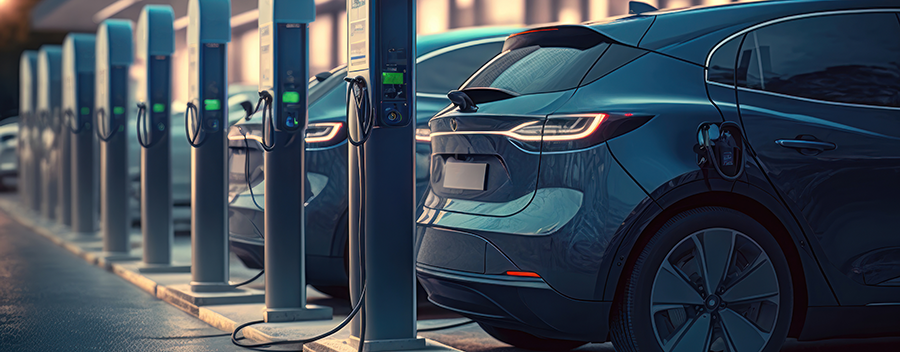The New Vehicle Efficiency Standard for industry, drivers and the environment
Australia’s New Vehicle Efficiency Standard commenced on the 1st of January, this year (2025).
Introduced as part of the Government’s National Electric Vehicle Strategy, the Standard aims to boost the number of affordable, fuel-efficient and low emission cars on Australian roads by legislating emission targets and incentives.
Prior to its enactment, Australia was one of only two advanced economies without a fuel efficiency standard. Citizens in other major economies have been benefiting from a range of affordable, fuel-efficient and low emission vehicles , whilst Australians have been using and spending more on fuel.
Having a standard in place aligns Australia’s vehicle market with most international ones , therefore encouraging the global supply of cleaner cars to the country and contributing to the decrease of noxious emission levels.

The driving need for cleaner cars
The Australian Government made a commitment, under the Paris Agreement and Climate Change Act 2022, to reduce the nation’s greenhouse gas emissions to 43% below 2005 levels by 2030 and achieve net zero emissions by 2050.
The transport sector in Australia alone accounts for 21% of the nation’s emissions, with passenger cars and light commercial vehicles being the largest producers. Without intervention, this number would significantly increase, causing transport to become the largest source of emissions.
To curb this momentum and work towards reducing carbon dioxide (CO2) emissions, the Government introduced a number of initiatives, including the Electric Car Discount, Driving the Nation Fund and Green Vehicle Guide.
The National Electric Vehicle Strategy was established as a concentrated effort to further improve the supply, infrastructure and consumer demand of low emission vehicles by supporting these initiatives and implementing new ones, such as the New Vehicle Efficiency Standard.

The New Vehicle Efficiency Standard in a nutshell
The Standard sets an annual CO2 emissions target for all new light vehicles sold in the Australian market from 2025 to 2029 and incentivises those who import under the targets. Each year, within the five-year period, the targets will decrease, and the Minister will set new benchmarks for 2030 and beyond.
The legislation does not restrict the type of vehicles that can be imported or purchased. Rather, the Standard encourages manufacturers and suppliers to import more fuel-efficient versions of all vehicle types, including petrol, diesel, hybrid and electric.

The vehicles covered under the Standard
The Standard applies to two vehicle types – passenger vehicles (including sedans, hatchbacks and most SUVs) and light commercial vehicles (including vans, utilities (utes) and some 4WD models). These are also referred to as Type 1 vehicles and Type 2 vehicles in the Standard, respectively.
Each vehicle type has its own annual emissions target which has been determined by incorporating characteristics such as vehicle mass.
Exempt vehicles
Vehicles with a gross vehicle mass (GVM) between 3.5 and 4.5 tonnes are exempt from the Standard. The Government made this determination as this class of road vehicle does not currently require mandated CO2 testing and manufacturers will not be able to comply with the Standard.
The determination expires at the end of 2029 to align with the cessation of the initial five-year period of the Standard.

The Standard requirements for suppliers
From the 1st of July 2025, any Type 1 or Type 2 vehicle entered into the Register of Approved Vehicles (RAV) will have their CO2 emission levels compared against the emissions target set in the Standard. The results of the comparison determine if the supplier is rewarded or penalised.
Here is a summation of the legislation:
- For each Type 1 or Type 2 vehicle entered that produces CO2 emissions below the vehicle type’s emissions target, the supplier will receive a negative value, and for each vehicle that produces emissions above the target the supplier will receive a positive value.
- At the end of the year, the values are tallied generating the supplier’s Interim Emissions Value (IEV).
- Suppliers with an IEV less than zero will receive tradeable units.
- Suppliers with an IEV greater than zero will have two years from after the IEV year to purchase or generate units to bring their Final Emissions Value (FEV) to zero. If they are not successful, they may be penalised.
Capturing emissions data
The New Vehicle Efficiency Standard Regulator is responsible for calculating and reporting on the IEVs and FEVs and determining whether CO2 targets have been met. The IEVs are calculated using data from the RAV, including carbon dioxide emissions, mass in running order, rated towing capacity (only for off-road passenger vehicles), and whether it is a Type 1 or Type 2 vehicle.
The Regulator is also responsible for ensuring compliance with the Standard, enforcing notices and penalties when applicable and maintaining the new Vehicle Efficiency Standard Unit Registry.

The Standard benefits to drivers and all Australians
Designed to help mitigate climate change and as a platform to raise the Australian vehicle market to international levels, the implementation of the Standard also offers valuable benefits to all Australians:
- Greater choice of new cars with advanced fuel-efficiency, low and zero emission technology across multiple brands and models . Global car manufacturers prioritise their supply of modern, fuel-efficient cars to countries with fuel-efficiency standards , and Australia is now of those countries.
- Greater access and affordability for all Australians with cleaner cars eventually being sold in second-hand markets.
- Saving money on fuel and maintenance. The Government estimates the Standard will save Australians over $95 billion in fuel and $13.85 billion in maintenance by 2050.
- Decrease in potential health issues such as heart and lung disease and cancer with reduced CO2 emissions. The Government estimates, as a result of the Standard, a reduction in approximately 321 million tonnes of CO2 abatement and a saving of $5 billion in health benefits by 2050.

Fuel efficiency and beyond
The New Vehicle Efficiency Standard is just one action the Government is taking to help build a more fuel-efficient transport sector. For example, the Government is also planning to implement improvements to the country’s fuel quality later this year.
The Standard, upcoming fuel quality changes and initiatives from the National Electric Vehicle Strategy all aid towards the country achieving its net zero emissions target.
Be sure to bookmark the HSE Bulletin so you can stay informed of upcoming climate actions and much more. A summary of legal obligations related to the New Vehicle Efficiency Standard can also be found under the Air category in EnviroLaw.
If you don’t have an Environment Essentials subscription, and are keen to learn how you can be more informed on this new Standard and other legislative requirements, then sign up for a free trial or get in contact with our Sales team.
References
- Department of Climate Change, Energy, the Environment and Water Publication: National Electric Vehicle Strategy
- Department of Climate Change, Energy, the Environment and Water Webpage: Net Zero
- Department of Climate Change, Energy, the Environment and Water Webpage: Reducing Transport Emissions
- Department of Climate Change, Energy, the Environment and Water Webpage: Regulating Australian Fuel Quality
- Department of Climate Change, Energy, the Environment and Water Webpage: The National Electric Vehicle Strategy
- Department of Infrastructure, Transport, Regional Development, Communications and the Arts Publication: New Vehicle Efficiency Standard Bill 2024 Explanatory Memorandum
- Department of Infrastructure, Transport, Regional Development, Communications and the Arts Publication: New Vehicle Efficiency Standard Fact Sheet
- Department of Infrastructure, Transport, Regional Development, Communications and the Arts Webpage: Australia’s New Vehicle Efficiency Standard – Frequently Asked Questions
- Department of Infrastructure, Transport, Regional Development, Communications and the Arts Webpage: Information for Drivers
- Department of Infrastructure, Transport, Regional Development, Communications and the Arts Webpage: Information for Industry
- Department of Infrastructure, Transport, Regional Development, Communications and the Arts Webpage: Role of the NVES Regulator
- Department of Infrastructure, Transport, Regional Development, Communications and the Arts Webpage: New Vehicle Efficiency Standard Act 2024
- Department of Infrastructure, Transport, Regional Development, Communications and the Arts Webpage: Road Vehicle Standards (Information on the Register of Approved Vehicles) Amendment Determination 2024
- Green Vehicle Guide Webpage: Vehicle Emissions
- The Office of Impact Analysis Webpage: Cleaner, Cheaper to Run Cars: The Australian New Vehicle Efficiency Standard